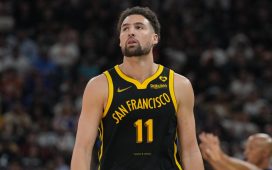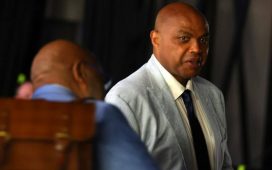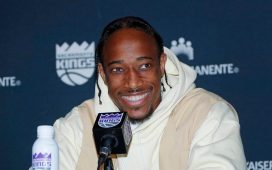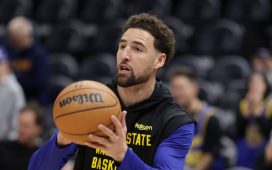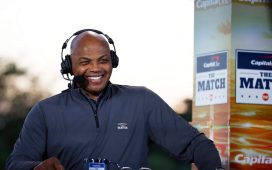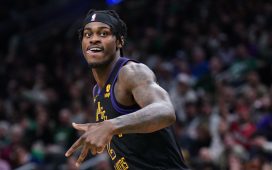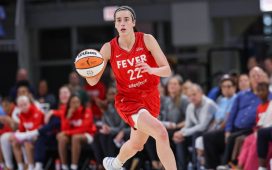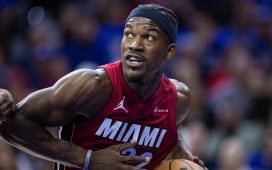What’s the opposite of “underrated”? Not “overrated,” exactly … at least for the purposes of this exercise.
Earlier this week, I wrote about five positive moves from the NBA offseason that aren’t getting enough attention, both for their potential impact and the creativity involved in executing them. Now it’s time for the other side of the coin — some moves that haven’t really received much negative press despite having significant downside. I wouldn’t call them “overrated” as much as “under-scrutinized” — and they left me with some questions.
I’ll note that not every iffy move from this summer qualifies. The entire internet took turns hammering the Chicago Bulls for trading Alex Caruso for Josh Giddey without getting any picks in return, so I’m not going to bother piling on. Similarly, the Denver Nuggets’ offseason was somewhere between underwhelming and depressing, but I’m not the first person to point that out.
I also didn’t include “non-moves” here, although it wouldn’t be hard to come up with a few. For instance, I’m still waiting to find out what the New Orleans Pelicans’ likely opening day lineup looks like — this can’t be it, right? I’m also assuming the Cleveland Cavaliers will eventually sign another player or three and fill out their roster.
Finally, there’s another class of contracts that technically might seem “bad” relative to an analytic model of expected return, but the teams had little choice but to pay or lose the player entirely. The new deals for Pascal Siakam, OG Anunoby and Nic Claxton, for instance, definitely fall into this category. Malik Monk’s new pact in Sacramento arguably fits here, too, and even the Philadelphia 76ers’ Paul George signing — the coup of the summer — likely falls into this bucket, as the tail end of his four-year, $212 million deal might be awful. Whatever. Flags fly forever.
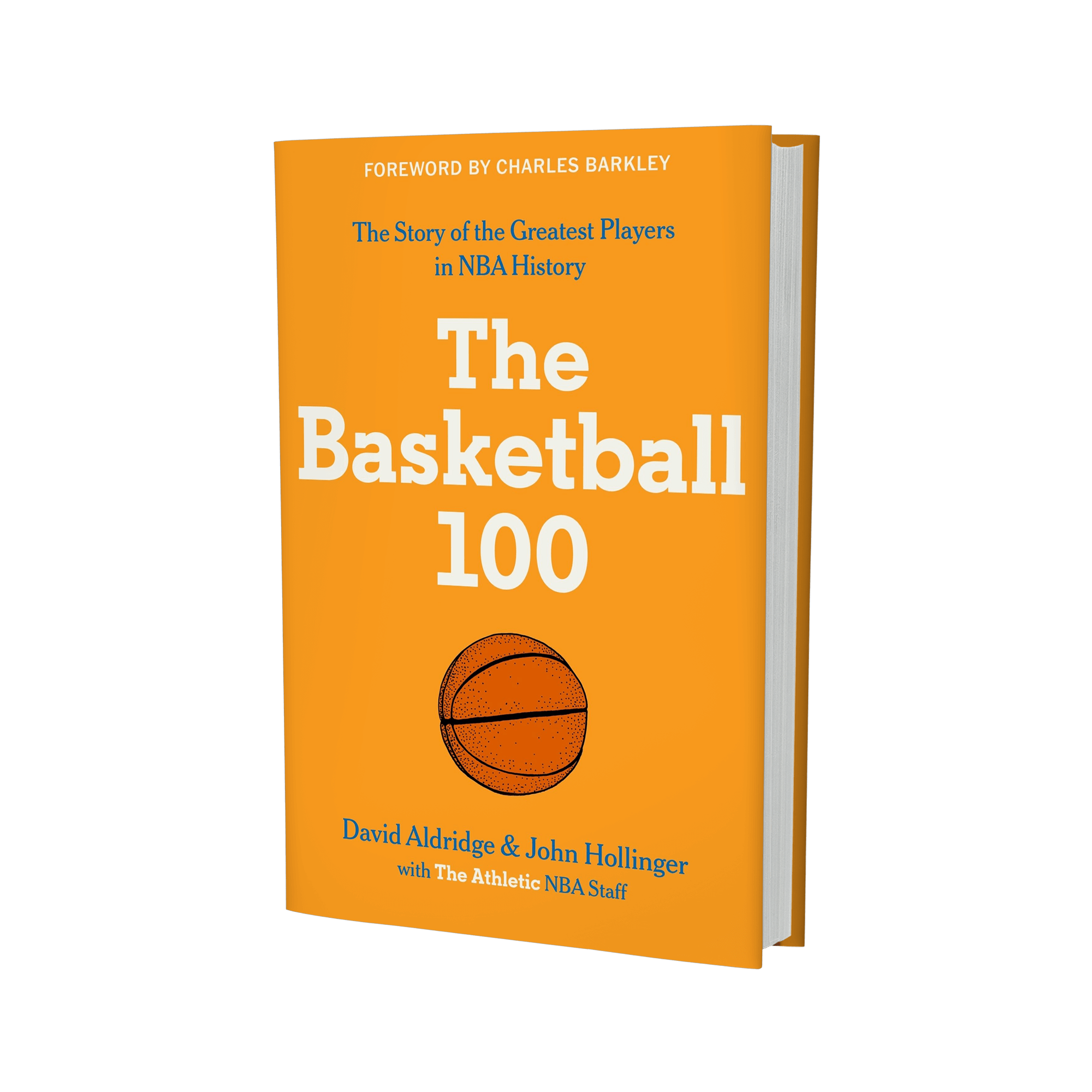
The story of the greatest players in NBA history. In 100 riveting profiles, top basketball writers justify their selections and uncover the history of the NBA in the process.
The story of the greatest plays in NBA history.
Nonetheless, that still leaves some moves about which I still have some questions. Here’s the top five on my “under-scrutinized” list:
Andrew Nembhard signed an extension with Indiana in late July, one that was reported as three years and $59 million. This one came late, while everyone was focused on the Olympics, so a lot of people shrugged their shoulders and said, “Yeah, three years for $59 million? Whatever, sounds OK.”
But on any extension like this, the thing to track isn’t the years and money, but the new years and new money. Indiana already had Nembhard under contract for two more seasons at a paltry $2 million and change each season. The extension wiped away the second of those years, which had been a Pacers team option.
Thus, the true value on this deal is two years and $57 million, which is wild for a player of his pedigree. Yes, Nembhard was good in the playoffs and is a plus team defender with a high overall basketball IQ; he also has a career PER of 10.6. If you think he’s really a 48.6 percent 3-point shooter, like he shot in 17 playoff games, then go nuts … but his career mark is 35.3 percent on middling volume.
Regardless of your opinion on Nembhard, it’s safe to say his becoming the type of player who commands $28 million a year in the open market is a right-tailed outcome from his current station in the league. Effectively, that’s what he was paid.
Additionally, it’s not as if this was the Pacers’ last chance to negotiate a deal like this. They had not one but two more windows left to extend Nembhard — one after next season and the second prior to his entering the 2026 free-agent market. Another year of information heading into next summer, one that helped define whether they were paying for short-term playoff vibes or something more durable, might have been really valuable.
Let’s look at the counterargument, though. One piece of small-market logic holds that retaining rights to players is paramount, and I lived this when I was vice president of basketball operations in Memphis. But even here, the deal falls a bit short: The contract Indiana gave Nembhard was the most the Pacers could pay annually, but the extension runs a year short of the maximum length. A team option for a final year at $19 million or so might have made this whole thing look more palatable.
In particular, the pain point of this deal is the 2025-26 season, where it seems to me the Pacers sacrificed way too much by changing his $2.2 million salary to $18.1 million. For a franchise that is never paying luxury tax, this one could hurt.
The Pacers likely have juuuuust enough room below the tax line (I’m projecting $33 million right now, but with only nine guaranteed contracts) to re-sign Myles Turner and pay their 2025 first-rounder, but they won’t be able to add anything beyond that and still may have to jettison another mid-sized contract to make it work.
Water can go under the bridge between now and next offseason, of course, but right now, it looks like they gave up the use of their nontaxpayer midlevel exception to pay an already-signed Nembhard more money … and didn’t really get much upside in return on the out years. We’ll see how it plays out.
The deal I would have considered doing in Indiana’s shoes would have been the exact same extension in years and money but tacked on after the cheap 2025-26 season — so the new years and new money was a true three-for-59 instead of two-for-57.
Nembhard isn’t turning into a max guy, and role-playing guards had an awfully hard time even getting midlevel exception money this summer. One could argue that even the reported three-for-59 money was a reach based on everything else that happened in the market.
While I love what the Pacers have done in general the last few years to get to the position they’re in, including recently breaking ground for my condo development on Furphy Island, I can’t say I was a fan of this one.

Free, daily sports updates direct to your inbox.
Free, daily sports updates direct to your inbox.
Extension victory laps
The Nembhard extension was the biggest example of a bigger class of offseason move from this summer that I’ll call the “extension victory lap.”
In particular, four players picked in the 2021 draft who wouldn’t make anyone’s list of top 20 players in the league got maximum rookie extensions with supermax language — Detroit’s Cade Cunningham, Toronto’s Scottie Barnes, Cleveland’s Evan Mobley and Orlando’s Franz Wagner. For a draft that has produced one All-Star — an Eastern Conference injury replacement, at that — it’s quite an outcome. It’s particularly notable when the career leader in PER and BPM from this draft is …. Alperen Şengün.
To be fair, each of the teams did get something in return for committing to paying the max: a full, five-year commitment with no player option. (All four max deals were identical in this respect.)
On the other hand, each also gave away some of the theoretical upside of the 25 percent-of-cap rookie max by stepping up to a supermax if the players makes All-NBA. Again, it’s a victory-lap scenario if the player is good enough to do that, but it also strips upside from the original deal. We’ll at least give Cleveland and Orlando some credit for limiting the supermax bump to 27.5 percent of the cap (not the max of 30 percent) if Mobley or Wagner manages to Julius Randle themselves onto third-team All-NBA.
Again, in the big picture, these teams all made good-to-great picks in the 2021 draft to get these four players; champagne all around. But it’s a big difference going from a rookie deal to a max, because a team’s max guys need to be stars. We’re not there yet, folks: Cunningham has a negative career BPM, and Wagner’s is plus-0.1. Wagner, Mobley and Barnes all have big questions about their shooting too. Surely, we can expect each to continue improving in the coming years. That said, if their production doesn’t arrow-up pretty sharply in the next 18 months, the value proposition on their deals will be underwater in the first extension year of 2025-26.
What makes this max-extension quartet so odd is teams have provided other successful road maps to handling situations like this. You’re allowed to negotiate, folks, and perhaps just as importantly, you’re also allowed to wait. A year ago, Philadelphia held the line on a Tyrese Maxey extension, used the additional cap space from his absurdly low cap hold to nab George and still got Maxey’s ink on a five-year, no-options max deal … even after he made the All-Star team.
We have other examples. New Orleans put in non-guarantee provisions in Zion Williamson’s extension even after he’d made an All-Star team; a year earlier, Memphis and Phoenix successfully held the line on max extensions for Jaren Jackson Jr. and Mikal Bridges, respectively. (For that matter, Houston appears to be doing the same this summer with Şengün and the second pick in that 2021 draft, Jalen Green.)
Meanwhile, heading into a 2025 offseason in which only one other team projects to have max cap space (that it could use to offer a max contact the original team would just match anyway after having their cap space on ice for a week while all the other free-agent possibilities vanish) … what, exactly, is the fear here? Angering somebody who hasn’t proven they’re a franchise player by not immediately agreeing to pay them like one?
I feel like the downside of ending with a good-player, not-so-good contact situation a la Deandre Ayton or Michael Porter Jr. has been massively underrated, and nobody learned anything from the Sixers.

GO DEEPER
Scottie Barnes and Immanuel Quickley will not only define Raptors, but Masai Ujiri
If you talk to people around the league, the general sense is that a Raptors organization that didn’t miss a trick for a half-decade run culminating in the 2019 championship has hit a little slump, shall we say, over the most recent five years. Did they take their eye off the ball in the post-title hangover? Was it inevitable that their run of success would hit a bad break or two? Is there some way we can blame the metric system?
In any event, I’m not sure Toronto’s 2024 offseason will be the one that turns the tide. The rebuilding Raptors gave a two-year, $25 million extension to a 33-year-old Kelly Olynyk and immediately watch him look dead-legged in the Olympics; the Barnes extension (see above) is defensible but also felt like a bit of a capitulation.
However, the move that raised the most eyebrows was Immanuel Quickley’s five-year, $163 million deal that can zoom up to $175 million if he hits certain incentives.
I think Quickley is an above-average player: He’s a good shooter, an underrated defender and a nearly Kyle Lowry-esque foul grifter. Advanced metrics love him, and, at 25, he’s still young enough to get better.
That said, his transition from playing mostly off the ball in New York to mostly on it in Toronto was a bit hard on the eyes at the end of last season, more than the top-line numbers make it look. The $32.5 million he’ll make this season is just barely south of the $35.1 million max for a player with four years of experience; he actually can get within a few centimeters of that max if his incentives come through.
For a player of Quickley’s caliber, that’s … wow. He’s basically making the same money this year as James Harden!
As ever with deals like this, another question also comes up: Against whom was Toronto bidding? Quickley was a restricted free agent, giving the Raptors all the leverage; meanwhile, I’m struggling to find the rival that was going to commit to paying him anywhere near this kind of money on an offer sheet.
One argument for maaaaybe committing this big was a pathway Toronto chose not to take. The Raptors could have used the strategy of the Sixers (see above) by declining Bruce Brown’s $23 million team option, not paying Olynyk and using Quickley’s low cap hold to enter the market as a significant cap room player. That would have been the one scenario in which an early agreement with Quickley — to be signed after all the cap-space business was done — might have been truly helpful.
Instead, the Raptors are on the books with more than $70 million committed to Barnes and Quickley in each of the four seasons after the upcoming one. Yes, there are other reasons for some limited optimism — RJ Barrett looks great, for instance, and this same front office has pulled rabbits out of hats before. In the moment, however, it feels like the Raptors painted themselves into a bit of a salary-cap corner without a roster that’s worthy of such a commitment.

Bulls forward Patrick Williams brings the ball up court against the Oklahoma City Thunder. (Kamil Krzaczynski / USA Today)
Tired: Hammering Chicago for not getting picks in the Caruso trade. Wired: Letting Chicago off the hook for the five-year, $90 million contract it gave Williams, with a fifth-year player option to boot.
I love the general concept of Chicago pulling the ripcord and going young, even if it came a year too late. On the other hand, Williams got paid because he was the fourth pick in the 2020 draft and because … actually I’m struggling with the rest of this.
He’s the type of player where the idea of what he can do is intoxicating, and being confronted with the reality of what he actually does is much less so. An athletic 6-foot-7 forward who is a career 41 percent shooter from 3? Oh my goodness, sign me up!
However, Williams still hasn’t shot 3s with enough frequency to really put a scare into defenses as a floor spacer (just 6.1 3s per 100 possessions last season), perhaps because he’s much more potent on catch-and-shoot corner 3s than from the rest of the floor or off the dribble. (Williams shoots a commendable 44.6 percent on corner 3s for his career but 38.8 percent from elsewhere.) One also can fairly argue that a rethink in Chicago’s general offensive philosophy might weaponize him to shoot more 3s.
For a low-usage player, Williams also takes way too many shots from suboptimal places. Though he’s also quite athletic, less than half his 2s come at the rim. He’s not a capable enough ballhandler to get there on his own steam and struggles to read the game in live action; as a result, he rarely draws fouls and too often defaults into one-dribble long 2s.
The endgame of all that is that his top-line numbers end up extremely meh: an 11.0 PER, 55.3 percent true shooting and minus-2.3 BPM last season, with similar numbers from his other three seasons. Despite his seeming athleticism, he’s an acceptable-but-not-great defender, while the board work is borderline embarrassing (7.9 percent rebound rate last season, just barely nudging him past Kyrie Irving and Damian Lillard).
Re-signing Williams wasn’t just a paper cost, either; Chicago could have been gifted Harrison Barnes and a free pick swap with Sacramento in the DeMar DeRozan deal if it hadn’t re-signed Williams. (With Williams on the books, adding Barnes would have put the Bulls deep into the luxury tax; despite playing in the league’s third-largest market, this line is basically an electrified fence for Chicago’s ownership.)
One can argue Williams turns 23 this summer and has upside left to explore, but this deal pays him as though it’s a sure thing he’ll get significantly better. It feels like a big leap of faith when he’s been there four years and barely improved at all.
There was definitely a number at which it made sense with Williams, but five years and $90 million with a player option isn’t it. And if another rival wanted to pay him that money … let them. It wasn’t any kind of existential threat to the Bulls.

GO DEEPER
To become more than a 30-win team, the Bulls will need a few breakout players
Max Christie was a bit of a cause célèbre for Lakers fans last season in a backup-quarterback kind of way. He was always the guy fans wanted to play instead of whatever mediocre veteran happened to be sabotaging L.A.’s second unit that night.
The problem was that A) they actually tried him quite a bit (944 minutes across 67 games), and B) he wasn’t any good (8.4 PER, minus-3.6 BPM), such that C) he couldn’t crack the full-strength rotation of what was arguably the worst bench in the league. Thus, it was a bit shocking to see the Lakers commit to a four-year, $32 million free-agent deal to bring him back, one that included a fourth-year player option. Talking to some other people around the league, I don’t think I’m alone in this opinion.
Christie is only 21, had an excellent 2023 summer league and is a good athlete. He has the basic, hazy outlines of a 3-and-D guy. Paying him room-exception type money still feels like a reach when actual 3-and-D guys struggled to get any more than that this summer, with the player option as an exclamation point. Nonetheless, in a Washington Wizards-type rebuilding situation, you might be more inclined to look the other way and try to take the long view.
That is … not the Lakers’ situation. What made this move particularly notable was that it took the Lakers out of other scenarios in free agency. Any team with LeBron James and Anthony Davis needs to be all-in on right now, and the Lakers seemingly passed up a few other opportunities to go in that direction. (We aren’t tapping their phones, so we don’t know exactly what they could have done, but they had three first-round picks and matching salary lying around this June. Who knows, maybe they still do something minutes after this article publishes.)
From that perspective, Christie was another opportunity cost, because the $7.1 million cap number for Christie essentially took the Lakers out of using their taxpayer midlevel exception while still staying below the second apron. (That latter consideration was necessary to keep any realistic in-season trade flexibility alive, which is why James took a slight haircut off the max on his new deal.)
The $5.2 million taxpayer MLE could have been used to target badly needed bench upgrades instead of running it back with almost entirely the same group. Lakers exceptionalism has its limits, but a small-ish exception like this, historically, has been a much more valuable chip in L.A. than in other places, because A) it’s the Lakers, and B) the role is to play next to James and hit fungoes. Even at the risk of Christie walking, that seemed like the better gamble at this point in the roster’s life cycle.
I’ll back off on this somewhat if L.A. ends up finding another way to a significant roster upgrade, especially if it doesn’t take the Lakers until February to find it. But right now, it’s the fifth and final member of my “all-under-scrutinized” summer transactions.
(Top photo of Immanuel Quickley and Max Christie: Mark Blinch, Ronald Martinez / Getty Images)
